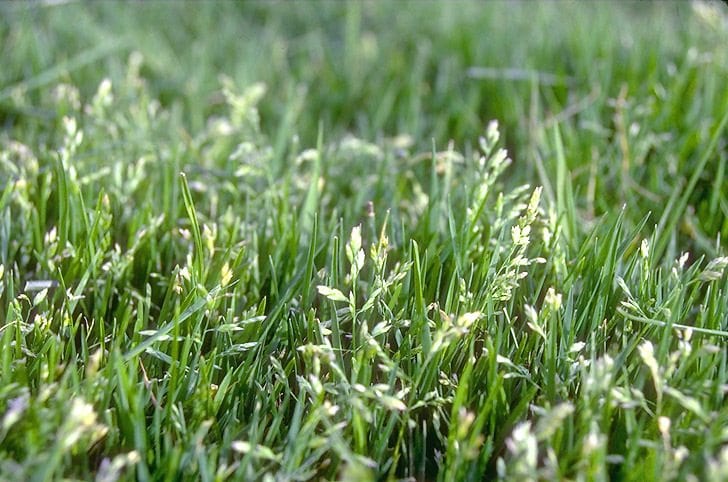ANNUAL BLUEGRASS

Annual bluegrass shows its ugly traits in lawns in early spring when it develops numerous and prolific seed heads. This causes a spotty, disturbing light green color mixed into your lawn. As the weather gets hot and dry, the light green patches die leaving bare spots. Poa annua is one of the most common weeds of highly maintained lawns. It is very problematic and difficult to control because of its prolific seed heads which distribute huge amounts of seeds into the lawn area. Due to heavy seeding coming from its prolific seed heads, annual bluegrass spreads very quickly. It only takes a few plants to cause problems. Poa annua prefers cool moist conditions and will usually die out in the heat of summer. But it has left an even greater area of seed deposits which will germinate again in the fall when the weather gets cooler.
Let’s examine the facts and life cycle of annual bluegrass (Poa annua).
It is a cool-season or winter annual.
Thrives in moist cool weather.
Dies in hot, dry summer weather.
Forms dense bright green patches.
Produces seed heads throughout the growing season.
A native of Europe that is found world-wide.
Each plant produces about 100 seeds.
Annual bluegrass is one of the five most widely distributed plants in the world.
The best weed control is always a thick turf filled with strong good grasses that will choke out undesirable grassy weeds or other lawn weeds.
Cultural practices you need to follow
Water infrequently and deep. I recommend ½ inch of water twice a week. If you have a sprinkling system see how long it takes to fill a saucer or cup ½ inch and then set the sprinkler for this time span twice a week. If you get natural rain, subtract the amount from your total for the week. Keep an empty cup exposed to rain to determine your water fall.
Poa annua thrives in moist conditions and does poorly in dry conditions so we don’t want to over water but we also want to supply enough water to develop strong turf to crowd out Poa annua with good grass varieties
Mow your lawn high 3 ½” and when seed heads are present, bag the seeds instead of returning them back into the soil. When seed heads are prolific, mow your lawn twice a week reducing the seed heads that form. Late spring is the peak of seed head production. Heavy compacted soils that retain lots of water encourage annual bluegrass invasion.
When bare areas occur in the summer I have developed a unique approach to follow which should work. Apply Corn Gluten to cover the bare and surrounding area. Germinate your proper grass seed for this area in a wheel barrow by mixing bags of sterile top soil with the seed mixture. Keep the seed moist and once the seed has been pre-germinated remove the mixture from the wheelbarrow and cover the bare area with a 2 inch top dressing of this soil. Keep the area watered until the seedlings take. The Corn Gluten will control new Poa annua seeds from germinating and the newly germinated grass will fill in the bare spots and help crowd out future germination of Poa annua. Once your grass becomes thick and filled with good grasses Poa annua will no longer be able to take a foot hold.
Read the “Organic Lawn” section in my book “12 Steps To Natural Gardening” and follow my formulas, my calendar and my recommendations. Remember the best lawn is an organic lawn. The deep roots you develop will make your lawn strong. The organic method for weed control in a lawn is to develop a turf lawn so thick of good grasses nothing will be able to penetrate it. Developing a good food web in your soil and an educated consumer following our organic program will lead to success.
The question arises where Poa annua seed come from. There can be many sources but basically it is so prevalent that very few lawns are not vulnerable to it. It can be spread by birds, wind or even your gardener’s lawn mower. Bare areas in your lawn can become very vulnerable.
Well managed lawns following the guide lines as outlined in my book will usually crowd out annual bluegrass by developing a strong turf of good grasses.
Some golf Courses have given up the fight and encourage keeping annual bluegrass alive by following a heavy watering program. Golf courses are in a dilemma for they are forced to follow a heavy watering program which encourages annual bluegrass to flourish. Poa annua is a bluegrass so when the seed heads are not there or when it does not go dormant in the heat of summer it is a nice looking grass. However for home owners it is a terrible weed and one we should battle to get rid of.



